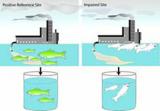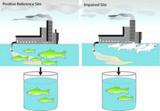Laboratory Tests of Site Media
Concept
Laboratory Tests of Site Media: Controlled exposure in laboratory tests to causes (usually toxic substances) present in site media should induce biological effects consistent with the effects observed in the field.
Examples
Consider persistent toxic substances as a candidate cause of decreased mayfly (Ephemeroptera) abundance. What findings support or weaken the case for toxic substances as the cause, based on laboratory tests of site media?
- Supporting evidence - When mayflies or other test organisms are exposed in the laboratory to water from the impaired site, significant mortality occurs relative to the controls.
- Weakening evidence - When mayflies or other test organisms are exposed in the laboratory to water from the impaired site, there is no difference in survival between test and control treatments.
This type of evidence most commonly is used to evaluate toxic substances or effluents. For example, sediments from a stream flowing through an industrial area may be tested in the laboratory using organisms such as Hyallela azteca, or Chironomus riparius. Such tests may be followed by Toxicity Identification and Evaluation (TIE) procedures designed to identify the specific toxic constituents of the media.
How Do I Analyze the Data?
Results from randomized, replicated, and controlled experiments are valued, because they control for some of the variability and confounding factors encountered under normal field conditions. Results usually are compared to two types of controls: an artificial sample prepared from neat chemicals or agents and a sample collected from an unimpaired field location. Extrapolation of the responses of test organisms to the responses of interest in the case (i.e., the observed biological effect) is usually required.
Because multiple potentially toxic constituents can occur in a sample, the conclusion that a sample is toxic does not identify the specific constituent responsible. The specific constituent responsible for toxicity can be identified using TIE procedures. In addition, mortality or other effects in tests of site media may be due to pathogens or to characteristics of the medium other than toxic chemicals.
What Evidence Would Support or Weaken the Case for a Candidate Cause?
- Data showing that survival or reproduction of laboratory organisms decreases with increasing exposure to media from the site
- Data showing that survival or reproduction of laboratory organisms increases with decreasing exposure to media from the site
- Data showing that survival or reproduction of laboratory organisms is unaffected by exposure to media from the site
How Do I Score the Evidence?
| Finding | Interpretation | Score |
|---|---|---|
| Laboratory tests with site media show clear biological effects that are closely related to the observed impairment. | This finding convincingly supports the case for the candidate cause. | +++ |
| Laboratory tests with site media show ambiguous effects, OR clear effects that are not closely related to the observed impairment. | This finding somewhat supports the case for the candidate cause. | + |
| Laboratory tests with site media show uncertain effects. | This finding neither supports nor weakens the case for the candidate cause. | 0 |
| Laboratory tests with site media show no toxic effects that can be related to the observed impairment. | This finding somewhat weakens the case for the candidate cause, but is not strongly weakening, because test species, responses or conditions may be inappropriate relative to field conditions. | - |
Helpful Tips
- Laboratory tests cannot be used to refute toxic effects in the field, due to differing field and laboratory conditions.
- Absence of toxicity in laboratory experiments may be due to more acute, episodic exposures in the field, or to observed biological effects based on species, life stages, or responses that are more sensitive than those used in the laboratory.


